Civilization: Call to Power
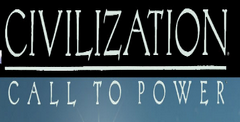
| a game by | Activision |
| Platform: | PC (1999) |
| Editor Rating: | 8/10, based on 1 review, 3 reviews are shown |
| User Rating: | 9.0/10 - 4 votes |
| Rate this game: | |
| See also: | Download Strategy Games, Civilization Games |
Strategy Guide
There are only three ways to win at Civilization: Call To Power, you can conquer the entire world using your military genius, lead the first civilisation in the race to synthesise an alien life form, or play out the full 7000 years of the game and go for the highest score. However, you don't have to decide which route to take right away, as the strategies and tactics employed are broadly the same in each case. You kick off with a settler, nine squares of visible terrain and a big black curtain covering the rest of the planet surface. Before you even touch anything, look at your 'radar' map in the lower-left corner. If you specified an earth-type world in the starting options, you can expect ice in the polar regions, so if you happen to be sited close to the top or bottom of the map, head the other way for the more fertile land.
Look at the square you're already in - will it make a reasonable city? If it's a food-producing square such as grassland and, even better, on a river, then build straight away. Ideally, you want two mountain squares and two forest or jungle squares inside the city radius. If you haven't got those, move two or three squares in a diagonal direction (or up or down the river if there is one) and see if things improve. Don't dally long though, even on a big and apparently empty map. It you slip behind your opponents in technology or growth, the next 7000 years or 350 turns will be a real struggle.
Defence Counsel
With your first city's foundations laid, the next step is a defensive unit, either a warrior or a phalanx, fortified in the city square. Next comes a unit for exploring - either a cheap and cheerful warrior or a horse archer. The latter are handy if the terrain is flat and open, but a complete waste of time in mountainous areas. Look around your continent methodically, moving diagonally where possible, because that way you uncover five squares a turn as opposed to three. Investigating ancient ruins close to your city is a bit risky unless your city is defended, but it can be worthwhile, especially if you grab a new advance.
If all is clear so far, aim for a second city. From now on, your moves are going to depend on what happens around you. If there's no sign of the opposition, start churning out more settlers. Aim to have about six to ten strong cities rather than 30-40 weakish ones. It's not wise to build them too close together -if they overlap, one of them will have fewer resources to harvest. On the other hand, if you're setting up one or two cities as specialist centres (see Combat Crisis? panel opposite) then it's not important. Keep them in a group so they're not too far from the capital. If you have to build on a less than ideal spot to achieve 'shape', don't worry. As you grow, try to keep your empire as rounded as possible - if you allow it to string out too far, you'll suffer from added unhappiness and awkward communications problems, at least until you acquire a railroad.
Economy Model
With building and exploration under way, the next 2000 years should ideally be devoted to growth, and to do that you've got to get to grips with your economy.
The first problem is whether or not to invest in public works (PW). Most cities will happily reach double-figure populations without any tile improvements at all. Farms and nets don't add a lot, frankly, but mines are useful in mountains as they increase gold as well as production, and pay for themselves quickly. Two essential city improvements are the granary and the.city wall, although the latter may be unnecessary if your city is well defended by military units or built on a mountain.
With two cities, switch PW to 10-20 per cent, purely to build roads to connect the cities later on. Roads reduce unhappiness and speed up reinforcements in the case of attack. However, if the general terrain is poor, consider increasing PW a little earlier.
Trade is essential. It's easy to underestimate its value but it does bring in significant gold, which can always be converted to production or science if needed. Aim to get at least one trade monopoly early in the game - this should ensure you don't run out of readies.
One of your biggest problems will be unhappiness, and the best way to combat it is through research. You'll also find that city improvements like temples, theatres and coliseums, plus wonders like Confucius Academy, all ease the situation. You can also take direct action in an emergency - if you're producing lots of gold, an increase in wages is a cheap way to cheer up the masses.
Warring Up Session
Starting a big war in the early stages of the game will only cause you grief. While you turn production over to the military, other civilisations will be researching themselves daft and accumulating cash. Not only that, but also any aggression is remembered by other civilisations, making it harder to deal with them later.
If you must wade in for whatever reason, try to get the enemy to declare war first by goading them and making excessive demands. That way your own reputation is untarnished. Also, try to fight a Nato-style war with limited objectives and stop when you've achieved them. If you're offered peace, take it-unless the civilisation in question is clearly going down the pan.
Only the advent of gunpowder gives you units that are really good enough to strike hard and defend themselves in return. Don't be fooled by the apparent power of knights - musketeers and cannon are far superior. They make a powerful combination, especially when used with cavalry to pin down the enemy.
Air units are good for bombardment and recon but shouldn't get involved with ground troops as they will take damage, especially against multiple units. Naval power can be crucial, especially on a waterlogged map. While you can eventually colonise the sea bed, the necessary technology comes very late in the game.
Strategic surprise is essential, whether you're playing against a human or an Al, because it takes up to ten turns to switch from peace to a war footing, and hopefully you can catch the enemy's units at half strength. Tactical surprise is also worth a try - if you land your forces from ships, a computer player doesn't react until they disembark. The same principles of war that work in the real world work in Call To Power. In order to win, you need to concentrate overwhelming firepower at a single point. But before you do that, do anything you can to get the odds in your favour: weaken cities by surrounding them and preventing reinforcement; remove improvements like city walls if possible; or incite riots. Then bombard the city with as many units as you can muster -cannons, ships of the line, tanks, artillery. Keep the bombarding units in their own stacks with a couple of other units to defend them. Spend no more than one or two turns in bombardment, or the enemy will build extra defences. Finally, attack with five close-combat units and four ranged units and hope for the best.
Combat Crisis?
To get to grips with Call To Power you must understand the combat system. The trouble is, the more you learn, the less you like it
In a stand-up fight between two units, each takes It In turn to 'hit' the other. The 'hit chance' is a unit's assault rating divided by the sum of its assault rating and the defender's defence rating. Let's say a knight with an assault rating of 3 attacks a phalanx with defence 2 without any terrain modifiers. The knight has a 3/(3+2), or 60 per cent, chance of hitting the phalanx. If it succeeds It does 1 hit point of damage; if it fails it takes 1 hit point of damage. The phalanx then strikes back with a 1/(1 +2), or 33 per cent, chance of a hit Again, if it succeeds It does a hit point of damage, or loses one If It falls. The process is repeated until one unit is destroyed.
In the original game's mechanics, as with Civilization II, the amount of damage done depended on a variable known as firepower', but here this appears to have been bypassed, and all units, no matter how powerful, do 1 point of damage per hit. Likewise, all units have just 10 hit points, for some equally obscure reason. It may be a 'feature' of the game or it may be fixed in the next patch. If you really can't wait, there's a text file on your hard disc in the Call To Powertctp data\default\gamedata\folder. You can edit UNITS.TXT with Wordpad and alter the hit point values - just remember to make a back-up copy first!
While our hypothetical knight will beat the phalanx most of the time, it should be made clear that if you add another phalanx or a defensive bonus, the task won't be anything like as easy. But what happens when a modem tank attacks a phalanx? In earlier versions of Civ the tank would win hands down; In Call To Power It could easily lose, especially against two phalanxes.
Any scrap in CTPis potentially dangerous to the attacker - modem interceptors can be brought down by a pair of phalanxes, and a fusion tank wiped out by a combination of pikemen and archers. In fact any defending ranged unit - such as a humble archer - can damage almost any other unit. Against two medieval cannons and a musketeer fortified in a city, you need to use at least six tanks or comparable infantry units to win.
This has two main effects on gameplay. Firstly, war is doubly expensive, as you need numerical as well as qualitative superiority. Secondly, civilisations that have fallen behind in technology can still defend themselves.
The key to attacking in CTP 'ts bombardment In true Nato style, you should pound enemy cities and strong points before you attack on the ground. Cannons and ships of the line are your first bombardment weapons, and should arrive in the renaissance era. if the enemy is still too strong, move into the modem age and go fiat out to develop steel to give you battleships against coastal cities, and oil refining and explosives to give you artillery. No city can stand bombardment for long. Once you've ground down the defences, move in with your land forces.
Download Civilization: Call to Power

System requirements:
- PC compatible
- Operating systems: Windows 10/Windows 8/Windows 7/2000/Vista/WinXP
Game Reviews
Without doubt one of the greatest games of all time, Sid Meier's Civilization has built up one of the strongest, most recognisable brands in the history of computer gaming. From the original Civ (as aficionados are wont to call it) in 1994, to the classic Civ II in 1996, gamers of all different age groups and backgrounds have learnt to spell the word civilisation incorrectly, as well as appreciate the work of a gaming genius at every click of the mouse.
It is for that reason alone that MicroProse and Activision/Avalon Hill (the owners of the original Civilization brand) recently locked horns over ownership of the name. One out-of-court settlement later and both MicroProse and Activision gain the right to publish their own game under the Civilization banner. Meaning potentially two Civ games for the price of one.
While most Civ fans will no doubt be sitting out there in consumerland thinking: Mmm, dat is good, ja? it will no doubt spark a buying dilemma when both games hit the streets. Which will be the best? Should I buy both? Will these games turn out to be remarkably similar, making it more difficult for you to choose between them? Well, we can't yet say in the case of MicroProse (we've not seen hide nor hair of their offering), but Activision seem to be on the right track, as the recent unveiling of Civilization: Call To Power quite clearly proves.
Fantasies And Strategies
As many of you will already know, the whole concept of Civilization - that of growth, research, war and good breeding - is a magical slice of historical hokum and turn-based strategy, all wrapped-up in a deliciously addictive coating.
Call To Power already shows signs of retaining that classic Civ depth and feel by sticking, pretty much, to the same tried-and-tested routine that we've all come to know and love.
And what is it exactly that makes the core of this game so good? Cecilia Barajas, Producer on Call To Power (and ex-criminal lawyer), explains: We identified two critical things that pretty much form the backbone of Civ's design. Number one is the essential fantasy of watching your civilisation go through time. It's a very simple concept, but it's a very powerful fantasy. In Civilization, as you know, you start off with a couple of settlers and by the end of the game you're huge. It's a big buzz after all that time you've invested in it.
The second thing is that there are literally millions of strategies for winning and playing the game. Civilization is pretty much the most replayable game ever made. Every single person has a different way of playing the game - and winning for that matter."
Which, with the benefit of hindsight, gives Cecilia and her team a firm base from which to start. A captive audience. With their mouths wide open, gagging for more. But what can you, Mr Joe Public Civ boy, expect by way of improvements?
Own Your Own Future
We're going much further into the future with this game, says Cecilia. Civilization II was roughly 4000BC to 2000AD; Call To Power goes from 4000BC to 3000AD, adding a thousand more years of civilisation development to the game. What that means is that you get new units, new governments, new wonders and new technologies.
Also, you get Cownership' of the future. In games such as Alpha Centauri or StarCraft, you are presented with futures that are cool - kind of given to you on a plate. In this game you create your own future. If your future is a Blade Runner future, where everyone is unhappy - there's pollution, crime - it's because you brought it about. If your future is a peaceful democracy - a Star Trek future, where everything is good and people are happy - then that will be your doing, too.
Cecilia continues: The second thing we're doing is including more strategies. Generally, there are two kinds of Civ players. There's the militarist, who just wants to kill everyone, or the peaceful scientist, who nurtures a democracy and wants to max out and enter the space race. We've added more what we term Cunconventional warfare' - the recognition that not all wars are fought on the battlefield, which as we know, because we live in our world right now, is totally true. For example, McDonalds has done more for capitalism than any war has. Mass markets are now infiltrating governments in a way that we never anticipated in the past.
Subversive Tendencies
Cecilia's experience as a criminal lawyer and hardcore gamer has helped her mould some of these new ideas and elements into a playable form. For example, injunctions can be imposed on other players when a system of law has been implemented, halting production and disrupting growth. Religious freaks can even go Chead hunting' in enemy territory, in order to embezzle cash from rivals. Anti-pollution units can raze whole cities to the ground in favour of grassland. Plagues can be released into rival towns in the hope that they will spread. Plus loads of other weird and wonderful subversive features that will only become apparent when the game is finished and properly balanced. And will no doubt scare Charlie Brooker half to death.
On top of all that there will also be - da da! - multiplayer network and Internet support. Something sadly lacking in the Civilization series until very recently.
Cecilia agrees: I think it was such an incredible compliment to Civilization II that it was able to sell so well, even shipping in 1996, without a multiplayer component.
Everyone on the Call To Power team is a big fan of multiplayer gaming. We play a variety of games most evenings after work for at least an hour. It's important to get the multiplayer aspects of Call To Power right, not only for us but for other people. So the game has very much been designed with multiplayer in mind. Not only will it cater for the kind of person who likes to play for 40 hours, but also for those who want to play for an hour, maybe in their lunchtime or after work.
Bang goes Christmas then.
Overview
I sat down at the computer this afternoon, thinking to sneak a few minutes of gameplay away from the kids. Three hours later I was still mesmerized, dinner wasn't ready and the kids were begging me to build force fields over my cities like Dad did. Yes, it's true. I'm a Call to Power addict. This latest entry in the ever-popular Civilization series is a streamlined, updated version of its older siblings, with every bit of the same appeal that those games still have.
Gameplay, Controls, Interface
Everything you loved about Civilization II is here, with bells on. The game is divided into five eras: Ancient, Renaissance, Modern, Genetic and Diamond (which tells me somebody over there has been reading Neal Stephenson). There are new Wonders for each age, new units, new City Improvements, new Civilizations (there's nothing quite like the joy of seeing the Phoenicians utterly destroyed by the Welsh! As long as you are the Welsh, that is).
The display has the familiar gridded landscape and below it is an improved control panel which lets you view and control the details of your individual units and cities. You can cycle through your active units as before, and also through your cities, to review your commands and settings. On the bottom left is the mini-map showing the land you've explored, which you can use to move the large display quickly to another part of the map. To the right is a pop-up menu with the Civilization Management screens to summarize information on all your cities, units, government type, etc. In these screens you can change city names, load queues of instructions for your cities, check your ranking and send diplomatic demands to your opponents.
The fully mouse-driven interface is fairly easy to handle. However, on the slower systems it's very easy to overshoot the mark when building things like roads and farms. Also, controlling unit movement can be tricky. To select a unit, you have to left-click on it, but to then select a city, you have to right-click elsewhere on the map and then left-click on the city. If you just left-click on the city, you'll send your unit there, which can be a pain. Controlling and "stacking" multiple units in a square is also improved. Unfortunately, when you put units on a ship, you can see how many more available spaces there are on the ship, but not which units are already there. This is a major disadvantage for players who like seafaring-centered civilizations. Otherwise, the controls are intuitive and simple to use.
Relationship to Previous Installments
There are a number of differences between Call to Power and Civ II, not all of them good. The A-Number-One All-Time Best difference is that now you can play multiplayer over the Internet or a local network. This was one feature I wanted on Civ II, and Call to Power has it (see below). You can now set up a queue of building tasks for cities, which is great except that, as with Civ II, a city will go on producing units forever unless you tell it to stop, so you have to stay alert. Other good differences include an extension of the game into space and undersea, the replacement of "city" units like Engineers with a Public Works fund for building roads and farms, and improved graphical control of units. Available technological improvements and Wonders now reflect more accurately a possible future for Earth, with all the advantages and drawbacks such technology affords. (And the AI Entity can and will take over your cities if you give it an opening.)
One difference I don't like as much is that when your opponents' turns are being processed, the display no longer automatically shifts to show you the movement of their units within sight of your cities or people. I kept having enemy Clerics and Diplomats show up unexpectedly. I also miss some of the old Wonders from Civ II, particularly Leonardo's Workshop. However, these are only minor drawbacks, and for the most part the differences between Call to Power and Civilization II are improvements.
Enemy AI
I normally played Civ II at the Chieftain level (one of the easiest) because I am lazy and I like to win. What surprised me about Call to Power was how very easy it was to win at that level; in Civ II that was at least a moderate challenge. I think the difficulty levels are now more realistic -- when it says Easy, that's what it is. And boy, do your computer opponents get upset over the littlest things! I mean, just because I had to wipe out the Phoenicians early in the game ...
Multiplayer
The simple fact that you can play Call to Power over a LAN or the Internet is a plus. I haven't played over the Internet, so I don't know how good or bad that experience is, but playing my husband over our LAN was great fun. The major disadvantage to any of the multiplayer games is inherent in any turn-based game; you have to wait for the other guy to finish. As turns become more complex later in the game, you can end up waiting a long time -- and the more people you have playing, the longer the wait. Otherwise, playing multiplayer is just like playing a regular game, but against one or more human opponents.
Graphics
I love it when a new version of an old favorite takes advantage of the latest technology, but remains recognizably the same. The Call to Power display is a refined, fancier version of Civilization II's grid; if your computer is fast enough (and mine isn't; bummer) you can select animated units, trade routes, and trade goods. I particularly like how the Settler yawns and stretches his arms after he finishes his move, like he's just finished a hard day's work. Well, in a sense he has ... However, while the game itself has finely-rendered graphical detail, the movies are disappointingly grainy. I have a 19" monitor and it was even worse on such a large screen.
Audio
With the CD in the drive, you can listen to a selection of music from many countries, from Africa to the British Isles. It's really good music and a definite improvement over _Civ II's repetitive soundtrack.
System Requirements
The minimum requirements for Windows 95/98 are a Pentium 133 MHz processor, 32 MB RAM, 320 MB uncompressed hard disk space plus 80 MB for the swap file, 16-bit high color video card with at least 1 MB RAM, 4X CD-ROM drive, DirectX 6 or higher (included with the game) and 100% Windows-compatible system. Windows NT requires all the above plus a Pentium 166 MHz processor, 64 MB RAM, and Service Pack 3. And yes, the game will run under the above conditions. However, running Call to Power with only the minimum requirements is extremely slow and I recommend turning off most of the special graphical features and, if necessary, reducing the display resolution. The faster your system, the nicer this game will look and the smoother it will play.
Documentation
The documentation is thorough on all levels -- the reference chart, the manual and the online help files. Between the three of these, you can usually find the solution to any problem. One drawback is that the manual, though very informative, is not indexed very well. You may simply have to read through the manual to find some answers, such as why you can't terraform the jungle right away or how to make your citizens love you enough to give you a celebration. Since I prefer to dive right into a game without reading the manual first, this was a drawback for me.
Installation and Setup
It's a big ol' game, but it doesn't take long to install. I did the maximum install and it took about fifteen or twenty minutes. But the biggest problem I had was that for some reason the game wasn't recognizing the CD in the drive, so of course it failed the copy protection. It wasn't until my intrepid husband changed the CD-ROM to synchronous data transfer that I was able to play. That's a fairly unusual problem and not mentioned in the online help files, so if you can't get past the Launch screen without being booted to your desktop, try checking your CD setup.
Patches & Updates
If you hop over to the Activision web site, you'll find all sorts of downloadable campaigns and discussions on customizing Call to Power. You can also find map editing tools, articles on the game, and other news. This feature takes Civilization: Call to Power out of the realm of mere simulation and into a much larger community of gamers. If you make up a scenario you're fond of, share it!
Bottom Line
Civilization: Call to Power is every bit as addictive and enjoyable as Civilization II, and a worthy successor to that game. Now, if you'll excuse me, I have to go whup the Cubans into submission.

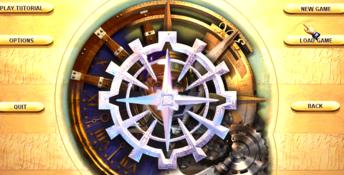

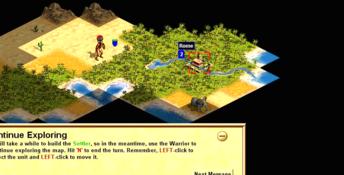
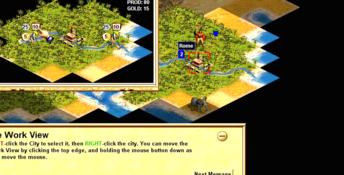
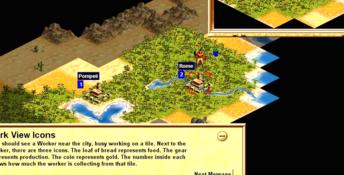
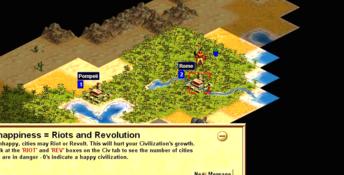
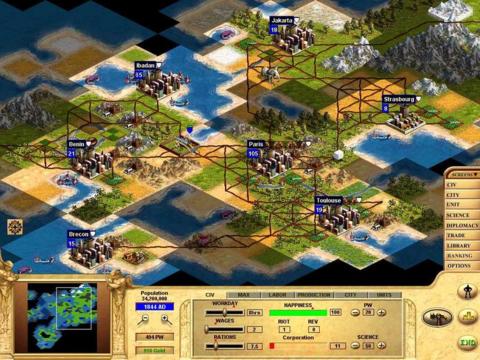



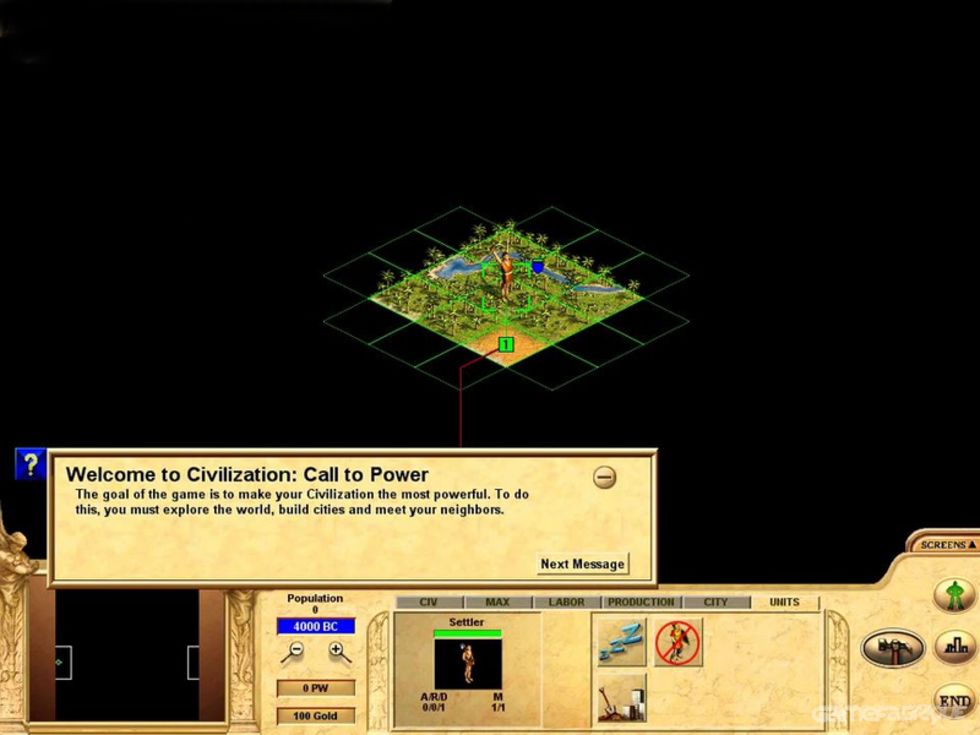






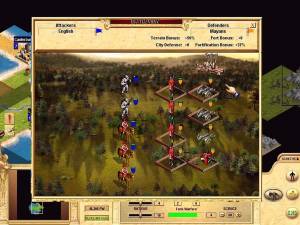


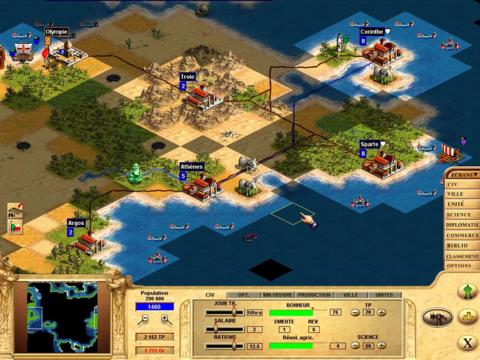

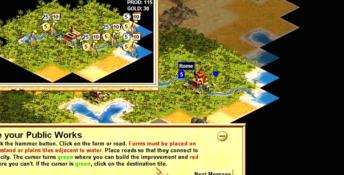
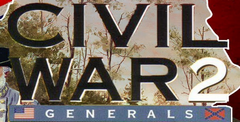 Civil War Generals 2: Grant, Lee, Sherman
Civil War Generals 2: Grant, Lee, Sherman
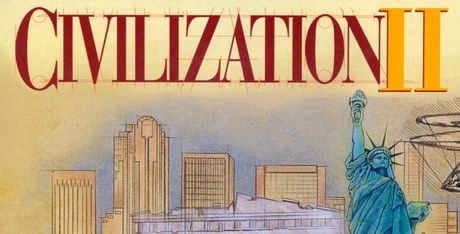 Sid Meier's Civilization II
Sid Meier's Civilization II
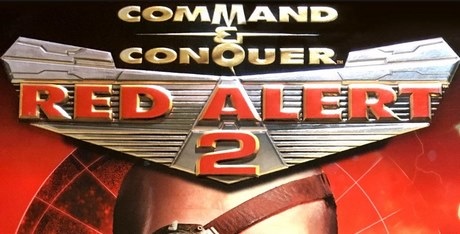 Command & Conquer: Red Alert 2
Command & Conquer: Red Alert 2 Master Of Orion
Master Of Orion